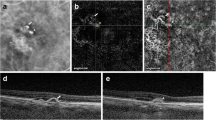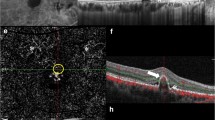Abstract
Background
Before treating polypoidal choroidal vasculopathy (PCV), the extent of the lesion should be determined, but the angiographic lesion size of PCV is sometimes different when comparing indocyanine green angiography (ICGA) and fluorescein angiography (FA). The purpose of this study was to evaluate angiographic findings and compare the lesion sizes of PCV on ICGA and FA using confocal scanning laser ophthalmoscopy (SLO) and fundus camera.
Methods
Thirty-seven eyes of 37 patients with PCV were examined by ICGA and FA using confocal SLO and a fundus camera, and the findings and the lesion sizes were compared during the early, mid, and late-phases of ICGA and FA.
Results
The polyps with abnormal vessel networks were depicted on ICGA in all eyes and the lesion showed classic-type leakage on FA in 15 eyes. Ten eyes with a pigment epithelial detachment (PED) had the maximal lesion size on FA because hyperfluorescent areas involving PED were determined as the lesions; although on ICGA, a PED distinguished from abnormal vessels was not included in the lesion. In 27 eyes without a PED, the early-phase of ICGA using confocal SLO showed the maximal lesion size in 24 eyes (89%) and the late-phase in three eyes (11%), and the maximal size on ICGA agreed on FA. While FA depicted the maximal lesion sizes in 24 eyes (89%), another three eyes showed the maximal lesion size on early-phase ICGA on confocal SLO. The maximal lesion size on ICGA using a fundus camera was smaller than when using confocal SLO in seven eyes (19%).
Conclusions
The ICGA on confocal SLO could visualize the more detailed findings of the abnormal vasculature of PCV and the FA showed hyperfluorescent regions overlaying the lesions. To determine the maximal lesion size on angiograms, early-phase ICGA using confocal SLO and FA should be referred.




Similar content being viewed by others
References
Chan WM, Lam DS, Lai TY, Liu DT, Li KK, Yao Y, Wong TH (2004) Photodynamic therapy with verteporfin for symptomatic polypoidal choroidal vasculopathy. Ophthalmology 111:1576–1584
Ciardella AP, Donsoff IM, Huang SJ, Costa DL, Yannuzzi LA (2004) Polypoidal choroidal vasculopathy. Surv Ophthalmol 49:25–37
Gelisken F, Inhoffen W, Schneider U, Stroman GA, Kreissig I (1998) Indocyanine green videoangiography of occult choroidal neovascularization: a comparison of scanning laser ophthalmoscope with high-resolution digital fundus camera. Retina 18:37–43
Iijima H, Imai M, Gohdo T, Tsukahara S (1999) Optical coherence tomography of idiopathic polypoidal choroidal vasculopathy. Am J Ophthalmol 127:301–305
Kwok AK, Lai TY, Chan CW, Neoh CL, Lam DS (2002) Polypoidal choroidal vasculopathy in Chinese patients. Br J Ophthalmol 86:892–897
Lee SC, Seong YS, Kim SS, Koh HJ, Kwon OW (2004) Photodynamic therapy with verteporfin for polypoidal choroidal vasculopathy of the macula. Ophthalmologica 218:193–201
Moorthy RS, Lyon AT, Rabb MF, Spaide RF, Yannuzzi LA, Jampol LM (1998) Idiopathic polypoidal choroidal vasculopathy of the macula. Ophthalmology 105:1380–1385
Okubo A, Sameshima M, Sakamoto T (2004) Plasticity of polypoidal lesions in polypoidal choroidal vasculopathy. Graefe Arch Clin Exp Ophthalmol 242:962–965
Otsuji T, Takahashi K, Fukushima I, Uyama M (2000) Optical coherence tomography of idiopathic polypoidal choroidal vasculopathy. Ophthalmic Surg Lasers 31:210–214
Quaranta M, Mauget-Faysse M, Coscas G (2002) Exudative idiopathic polypoidal choroidal vasculopathy and photodynamic therapy with verteporfin. Am J Ophthalmol 134:277–280
Shiraki K, Moriwaki M, Yanagihara N, Kohno T, Miki T (2001) Indocyanine green angiograms of choroidal nevi. Comparison between confocal and nonconfocal scanning laser ophthalmoscope and fundus video camera. Jpn J Ophthalmol 45:368–374
Sho K, Takahashi K, Yamada H, Wada M, Nagai Y, Otsuji T, Nishikawa M, Mitsuma Y, Yamazaki Y, Matsumura M, Uyama M (2003) Polypoidal choroidal vasculopathy: incidence, demographic features, and clinical characteristics. Arch Ophthalmol 121:1392–1396
Silva RM, Figueira J, Cachulo ML, Duarte L, Faria de Abreu JR, Cunha-Vaz JG (2005) Polypoidal choroidal vasculopathy and photodynamic therapy with verteporfin. Graefe Arch Clin Exp Ophthalmol 243:973–979
Spaide RF, Yannuzzi LA, Slakter JS, Sorenson J, Orlach DA (1995) Indocyanine green videoangiography of idiopathic polypoidal choroidal vasculopathy. Retina 15:100–110
Spaide RF, Donsoff I, Lam DL, Yannuzzi LA, Jampol LM, Slakter J, Sorenson J, Freund KB (2002) Treatment of polypoidal choroidal vasculopathy with photodynamic therapy. Retina 22:529–535
Treatment of Age-Related Macular Degeneration with Photodynamic Therapy (TAP) Study Group (1999) Photodynamic therapy of subfoveal choroidal neovascularization in age-related macular degeneration with verteporfin: one-year results of 2 randomized clinical trials-TAP report. Arch Ophthalmol 117:1329–1345
Uyama M, Wada M, Nagai Y et al (2002) Polypoidal choroidal vasculopathy: natural history. Am J Ophthalmol 133:639–648
Yannuzzi LA, Ciardella A, Spaide RF, Rabb M, Freund KB, Orlock DA (1997) The expanding clinical spectrum of idiopathic polypoidal choroidal vasculopathy. Arch Ophthalmol 115:478–485
Yannuzzi LA, Wong DWK, Storzolini BS, Goldbaum M, Tang KC, Spaide RF, Freund KB, Slakter JS, Guyer DR, Sorenson JA, Fisher Y, Maberley D, Orlock DA (1999) Polypoidal choroidal vasculopathy and neovascularized age-related macular degeneration. Arch Ophthalmol 117:1503–1510
Yuzawa M, Mori R, Haruyama M (2003) A study of laser photocoagulation for polypoidal choroidal vasculopathy. Jpn J Ophthalmol 47:379–384
Yuzawa M, Mori R, Kawamura A (2005) The origins of polypoidal choroidal vasculopathy. Br J Ophthalmol 89:602–607
Author information
Authors and Affiliations
Corresponding author
Additional information
The authors have no proprietary interest in any aspect of this report.
Rights and permissions
About this article
Cite this article
Gomi, F., Sawa, M., Mitarai, K. et al. Angiographic lesion of polypoidal choroidal vasculopathy on indocyanine green and fluorescein angiography. Graefes Arch Clin Exp Ophthalmol 245, 1421–1427 (2007). https://doi.org/10.1007/s00417-007-0564-y
Received:
Revised:
Accepted:
Published:
Issue Date:
DOI: https://doi.org/10.1007/s00417-007-0564-y




